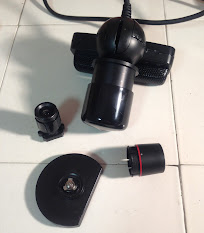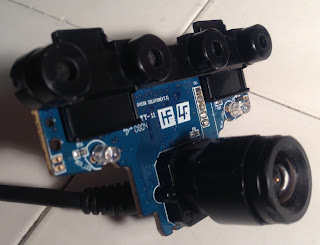 |
| PS3 Eye webcam with standard lens removed and replaced with 1.25" telescope nose piece, with threaded IR filter |
Actual test images pending - I need a clear night without other commitments.
Opening the case
This is surprisingly tricky. First, there are four screws on the back hidden behind glued on covers, which must be removed. Then the hard part - using a flat screwdriver or two, pop the seam all the way round. The main rectangular part of the casing is held by three clips (marked) which are quite easy, but there ball part is held by a pair of strong clips (also marked). This video from Peau Productions helped, but have a look at the full sized version of the images here to understand where the clips you are aiming for are.
 |  |
| Back of PS3 Eye with screw covers removed. | Back casing, highlighting three easy clips (blue), and the two difficult clips (yellow) |
 |  |
| PS3 Eye opened, showing easily broken catches (blue) and one of the two difficult ones to open (yellow) | PS3 Eye opened with stand removed, held by two screws. |
Once the back of the case is removed, the base is easily freed by removing another pair of screws. I decided for telescope use to remove the heavy flat foot - but the screw holding this on didn't unscrew. In the end I used a hacksaw to free this - and once reassembled covered the slot with insulating tape.
Now just two screws must be removed to free the board, the most left and most right. Don't remove the lens holder unless you need to (in case you get it dirty), and likewise there is no point removing the microphone cover (held by three screws).
Telescope mounting
Thanks to other bloggers like this one, I knew there was a standard M12 board lens holder into which a ready made 1.25" nosepiece should screw in for use with a telescope. I also knew from post like this that least two variants of the PS3 Eye camera's lens and IR filter, often with lots of glue making disassembly hard.
 |
| Front of PS3 Eye PCB with lens mount removed, exposing the image sensor (bottom). |
 |
 |
| PS3 Eye Lens and mount with red glass IR filter at base | |
Luckily this worked nicely with my existing 1.25" Astro Engineering AC378 nose-piece adapter, without having to cut away any of the PS3 Eye's casing. For a shorter height M12 board lens mount used, you may need a hacksaw to modify the case.
 |  |
| Modified PS3 Eye, with dust cap, and removed lens parts and foot | PS3 Eye webcam with standard lens removed and replaced with 1.25" telescope nose piece, with threaded IR filter |
I've not shown the front casing and how to remove the original twisting lens covering (quite a clever design - the lens itself has a twist action for a wide-angle and zoom setting). The outer lens casing is retained via four clips - I removed it by bending one clip at a time and holding them open with small jewellers' screwdrivers as a wedge. This was a bit fiddly, so if you don't need this part a little force could just break these clips.
Windows Drivers
There is company doing Windows PS3 Eye drivers, but as I don't have a Windows machine at home anymore I didn't explore this.
No joy under Mac OS X
Video for the PS3 Eye does not work out of the box on Mac OS X "Mountain Lion" 10.8, but the microphone does. Here's what it says at the command line:
$ system_profiler SPUSBDataType
...
USB Camera-B4.04.27.1:
Product ID: 0x2000
Vendor ID: 0x1415
Version: 1.00
Speed: Up to 480 Mb/sec
Manufacturer: OmniVision Technologies, Inc.
Location ID: 0xfa130000 / 6
Current Available (mA): 500
Current Required (mA): 500
According to these guys' detailed tear-down, that version string B4.04.27.1 matches this being a newer version with the OV538 USB chip (see photo above, unlike the older B3.04.06.1 with an OV534 chip). The serial number on the base is S/N 8X0066138, and says it is a SLEH-00201 manufactured by Namtai for Sony.
So, driver time - this should work with the Macam PS3 Eye driver, although they do warn about high bandwidth needs. I tried both macam.0.9.2.dmg (the current release), and the latest development build macam-cvs-build-2009-09-25.zip (several years old - not a good sign for the project's health), and while they could capture still images at VGA resolution (640 x 480 pixels), there was no live video and when trying to record video the PS3 Eye made the macam app crash.
This rules out using my nice light Mac laptop with the telescope and this camera :(
Linux Support OK
Linux includes drivers so this is very easy - it just works. However, on an older kernels the drivers are less functional (e.g. no choice of resolution or frame rate). The PS3 Eye camera even worked out of the box with Skype.
$ lsusb
... ID 1415:2000 Nam Tai E&E Products Ltd. or OmniVision Technologies, Inc. Sony Playstation Eye
However, wxAstroCapture didn't seen to recognise it. For now using guvcview gives some promising results in terms of control over gain/exposure.
Testing
Waiting for clear skies on a free evening... I'll update this post later.
The PS3 Eye's USB cable is almost exactly 2m long, quite useful for connecting a laptop to a camera on your telescope.


So did this ever work?
ReplyDeleteWork has been busy and it doesn't get properly dark here in summer (still a bluish sky at 10pm), so sadly I'm still waiting.
Deletehello i did the same thing and the best thing is if running under windows this camera has a really long shuttertime of 10sec for long exposure video! please look into this it really works im using it as a cheap but good guiding camera.
ReplyDeleteHello can you tell me PLZ if the sensor CMOS or CCD
ReplyDeletedid it work??
ReplyDeleteYes, but I never found the time to follow up on this to judge how well 😢
Delete